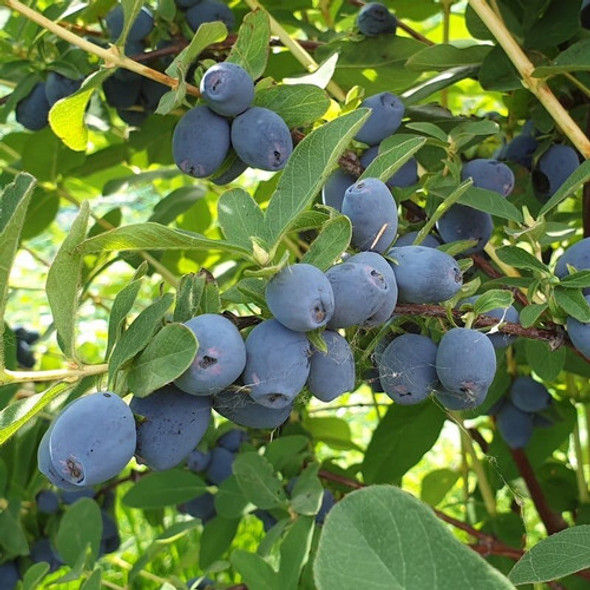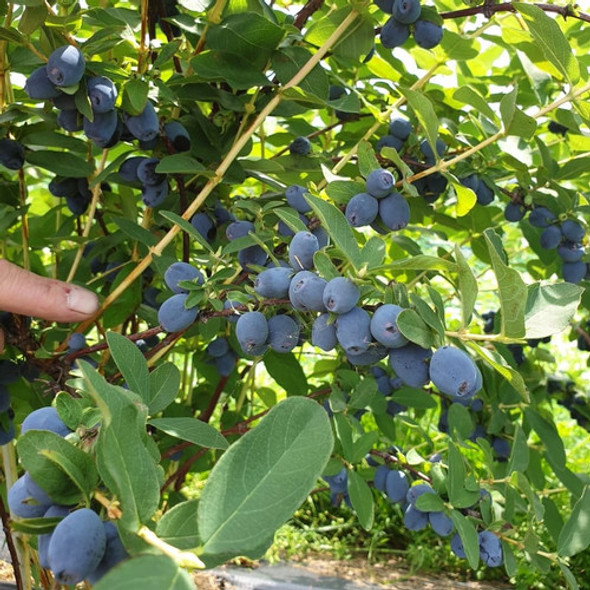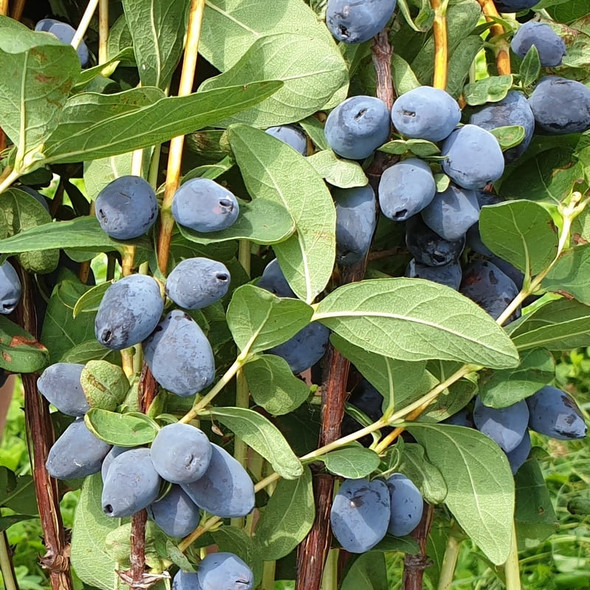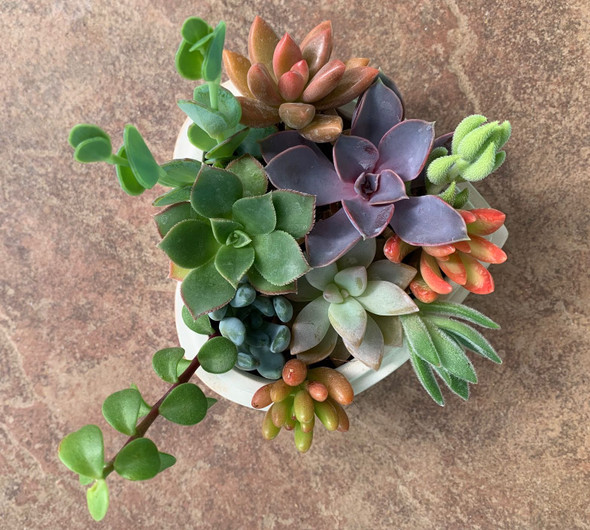Honeyberries - Haskap
Honeyberries are entering Summer Dormancy ! Yellow/Brown foliage and loss of leaves is normal. More information can be found here.
Please, review the information on the General Growing Tips page.
- Product
- Qty in Cart
- Quantity
- Price
- Subtotal
-


Blue Treasure Honeyberry Haskap
$24.99 - $42.99Honeyberry Blue Treasure ( Late)- Tissue Cultured plant BLUE TREASURE TM ORIGIN: JAPANESE TRADEMARK: UNITED STATES PPAF: EXPIRES 2038 – PROPAGATION PROHIBITED Hardiness Zone/Chilling Hours:...$24.99 - $42.99 -


Blue Typhoon Honeyberry Haskap
$21.99 - $59.99Buy from BerriesUnlimited to be sure that you get the real Blue Typhoon variety you are looking for! Blue Typhoon ( Late) BerriesUnlimited . Strawberry Sensation Family- Tissue Cultured plant ORIGIN: JAPANESE ...$21.99 - $59.99 -


Strawberry Sensation Honeyberry Haskap
$39.99 - $49.99Buy from BerriesUnlimited to be sure that you get the real Strawberry Sensation variety you are looking for! Strawberry Sensation (Very Late)- Tissue Cultured plant STRAWBERRY SENSATION TM ORIGIN: JAPANESE ...$39.99 - $49.99 -


Giant's Heart Honeyberry Haskap
$21.99 - $29.99Giant's Heart Honeyberry Haskap - Tissue Cultured Plant Buy from BerriesUnlimited to be sure that you get the real Giant Heart ( Giant's Heart) variety you are looking for! Giant's Heart (Late). Blue Treasure Family- Tissue Cultured...$21.99 - $29.99 -


Blue Banana Honeyberry Haskap
$18.99 - $39.99Blue Banana Honeyberry Haskap - Tissue Cultured plant Buy from BerriesUnlimited to be sure that you get the real Blue Banana variety you are looking for! BLUE BANANA TM ORIGIN: RUSSIAN TRADEMARK:...$18.99 - $39.99 -

"The World is Our Garden" Digital Gallery
$0.00Our Mission: To make the World as Beautiful as a Garden!$0.00 -


10-Sweet Honeyberry Haskap Hedge Plants
$299.99We offer 10 honeyberry bushes in this Sweet Honeyberry Hedge Berries Unlimited Package: 5 Blue Treasure 5 Blue Typhoon Easy to take care. You will get both, delicious berries and beautiful hedge to keep your privacy. Spacing 5-6 ft. Zone 2-7. ...$299.99 -


Red Candy Lingonberry
$18.99 - $24.99Vaccinium PP# 22,105. Lingonberry- vaccinium vitis-idaea Red Candy. Breeder: Botanic Experience BV. The Netherlands. Vaccinium ‘Red Candy’ is also known as Lingonberry or Cowberry Bush. Lingonberry jam is very famous in Sweden but...$18.99 - $24.99 -
On Sale

"Twelves Cuties" Rare Succulent Cuttings
Now: $19.99Was: $29.9912 different shapes, structures and colors of beautiful and healthy succulent cuttings for a good price to arrange your own planter and get some positives being busy with "indoor house gardening" while we are all at home most of the time!...Now: $19.99Was: $29.99 -


Trellis Netting
$9.99 - $17.99Heavy-duty, tangle-free nylon netting is ideal for growing tomatoes, peas, and vining crops. Harvesting is easy with its large reach-through mesh. Lifetime guarantee.$9.99 - $17.99 -


Heavy Duty Bird & Pond & Pool Netting
$9.99 - $69.99Stronger Netting for Bird protection. Keeps falling leaves out of ponds and pools, and protects goldfish and Koi from cats and other predators. Protective polypropylene floating net with UV inhibitors has small...$9.99 - $69.99 -

Bird-X Protective Netting for Fruit & Vegetables
$14.99 - $19.99Bird-X Protective Netting for Fruit & Vegetables Protects fruit and berries from thieving birds and other garden pests. Durable 3/4" polypropylene mesh with UV inhibitors. Easy to use.$14.99 - $19.99
Recent research proves that honeyberries have nearly three times the number of antioxidants as wild blueberries have. Unique berries: one of the most delicious and the healthiest at the same time!
Uses for Haskap Berries include Fresh/frozen eating or for any preserves: jam- jelly- juice-wine etc., cooking (sauces), or baking. The best-ever source of natural antioxidants for your well-being!
In selecting Honeyberry varieties, it is important to have a good pollinator. You should always remember that Honeyberries require at least 2-3 varieties for cross-pollination. The more varieties you have the better pollination production.
(Zhimolost’(Жимолость)- Russian common name
Haskap-Hasukapu-(Haskapa)- Japanese common name
Camerise- French-Canadian common name
Japanese Honeyberry/Haskap Berry
Fruit 1 week before strawberries or at the same time.
Russian Honeyberry/Zhimolost'
Russian Honeyberries fruit 2 weeks before strawberries.
Latin names for original wild ones are:
Lonicera Caerulea v. Edulis Turcz.
v. regiliana Boczkar.
v. Kamtschatica
v. Turczaninowii Pojark. (Russian wild ones)
Lonicera Caerulea v. Emphyllocalyx (Japanese, Far East of Russia wild ones).
Why Buy Honeyberries from Berries Unlimited
Berries Unlimited has been breeding and producing Honeyberries (Lonicera caerulea/Zhimolost'/Blue Honeysuckle/Haskap) for 14 years.
Our Honeyberries have Russian (Far Eastern part of Russia from the North to the South) and Kurils/Japanese origin.
We have released more than 30 of our varieties.
Berries Unlimited is the leader in the production of Honeyberries in North America. We are also the largest exporter of Honeyberries in the United States. Our varieties are very popular in Europe. They have been sold there since 2016 and turned into high demand there.
Don't forget to check out our option for Honeyberry Plants Wholesale!
For International plant large sales ( Canada) and plug sizes contact Vegetolab Inc.,6502 Avenue du Pont Nord, Alma Qc.G8E 1X7 418-347-1737 poste 223.
For the USA wholesale and commercial (36-flats/6 cm cells). Please call: 479-846-6030. For smaller amounts in the USA, please, order on our website.
Honeyberry Summer Dormancy
Be sure to note, that after our plants gain new branches/ leaves, and the weather is hotter and hotter, our plants in pots in our Zone 7 fall into summer dormancy sooner and it lasts longer through the hot season.
Plants gain some mold on the leaves from overhead watering and from the heavy spring rains, then the leaves start looking unhealthy and damaged. That is NORMAL!
Then they can start losing leaves in hotter climates and leaves look like they look right before winter comes: do not get upset: they are just falling into sleep-summer dormancy- to gain new buds: some to open later when it is cooler again closer to the fall, some buds - for the future new crop in spring.
Honeyberry Growing Habit
It is the of August- Mid-September when the plants start gaining again their new beautiful green, brownish/ reddish turning green foliage.
Being planted they keep their summer foliage much better when they are very well established (in a year or so.
After your plants finish bearing their leaves start looking worse and worse getting brownish/blackish/moldy (especially with growing humidity and heavy rains), even dry if it is lack of water through the new hot season as if they got damaged, but that is NORMAL for humid or too dry climates!
The cooler and nicer summers in your climatic zone the better your plants look in summer.
Their roots are 'bast' type roots. That is normal.
Please, do not add any acidic mulch around honeyberries and leave an approximately 2-foot mulch-free spot around your plant when You plant them until it is rooted in and established. Please, weed all the grass around at least 4 '. Start with 2 inches high mulch level. You should add pine mulch for heat or winter protection when the plants are well-established and after they give some new growth (in about 1- 2-3 months depending on the weather and season). Other mulch is too acidic or may have undesirable fungus.
Read our "Honeyberry Growing" page for more information on how to grow

